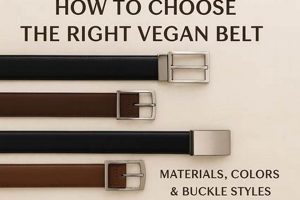Footwear, mirroring the elegance and formality of traditional dress shoes, can now be sourced entirely from materials devoid of animal products. These items provide an alternative to leather-based options, employing materials such as polyurethane (PU), microfiber, and recycled plastics to construct uppers, linings, and soles. These materials offer durability and aesthetic versatility, allowing for a range of styles from classic oxfords to contemporary loafers.
The increasing consumer demand for ethically sourced and sustainable products has driven the development and availability of these alternatives. Choosing such footwear aligns with values emphasizing animal welfare and environmental responsibility. Historically, limited options were available; however, advancements in material science and manufacturing have led to a wider selection of styles and improved quality, making these items increasingly accessible and desirable.
The following sections will delve into the various materials utilized in the production of this specialized footwear, explore notable brands and manufacturers, address concerns related to durability and maintenance, and consider the overall impact on the fashion industry and consumer choices.
Essential Guidance for Purchasing and Maintaining Footwear Without Animal Derivatives
Selecting appropriate and long-lasting footwear produced without animal products requires careful consideration. The following guidance aims to inform the discerning consumer regarding material selection, proper care, and responsible purchasing practices.
Tip 1: Material Evaluation: Scrutinize the material composition. Polyurethane (PU) and microfiber are common choices. Verify the quality of these materials, prioritizing those known for durability and resistance to wear.
Tip 2: Construction Assessment: Inspect the shoe’s construction. Strong stitching and a well-bonded sole indicate longevity. A robust construction minimizes the risk of premature failure.
Tip 3: Size and Fit Verification: Proper fit is paramount. Ensure accurate sizing to prevent discomfort and premature wear. Ill-fitting footwear is subject to increased stress, reducing its lifespan.
Tip 4: Surface Protection Implementation: Apply a protective sealant or spray designed for the specific material. This will create a barrier against moisture and stains, extending the shoe’s aesthetic appeal and durability.
Tip 5: Routine Cleaning Protocol: Establish a regular cleaning schedule. Use a damp cloth and mild detergent to remove dirt and debris. Avoid harsh chemicals, as they can degrade the material.
Tip 6: Appropriate Storage Practices: Store footwear in a cool, dry environment, away from direct sunlight. Use shoe trees to maintain shape and prevent creasing. Proper storage prolongs the life and appearance of the footwear.
Tip 7: Ethical Brand Consideration: Research the brand’s commitment to ethical manufacturing and sustainable practices. Supporting companies with transparent supply chains ensures responsible consumption.
By adhering to these guidelines, consumers can make informed decisions, ensuring both the longevity and ethical sourcing of their chosen footwear.
The subsequent sections will explore specific brands and models that exemplify quality and ethical production within the footwear industry.
1. Materials
The selection of materials is paramount in the production of footwear designed to exclude animal products. Material choice fundamentally dictates the aesthetic, durability, and ethical profile of these items.
- Polyurethane (PU)
Polyurethane serves as a primary substitute for leather in the uppers and linings. Its versatility allows for mimicking the texture and appearance of traditional leather, while also offering water resistance. The environmental impact of PU production, however, is a consideration, as its creation involves petroleum-based processes. Refinements in PU manufacturing aim to reduce volatile organic compound emissions and improve recyclability.
- Microfiber
Microfiber materials are increasingly used due to their enhanced breathability and durability compared to standard PU. Constructed from synthetic fibers, microfiber offers a soft texture and is often used in linings to enhance comfort. Its production generally requires less energy than traditional leather tanning, presenting a potentially more sustainable option.
- Recycled Plastics
Incorporating recycled plastics, particularly from post-consumer bottles, into shoe soles and occasionally uppers addresses environmental concerns related to plastic waste. This approach reduces the dependence on virgin materials and diverts waste from landfills. The quality and durability of recycled plastics are critical factors in ensuring the longevity of the finished footwear.
- Natural and Plant-Based Alternatives
Innovative materials derived from plant sources, such as apple leather (produced from apple waste) and pineapple leaf fiber (Piatex), are emerging as viable alternatives. These offer a renewable and potentially biodegradable alternative to synthetic materials. The scalability and widespread adoption of these materials remain areas of ongoing development.
The ongoing innovation in material science is expanding the possibilities for producing high-quality footwear without the use of animal products. The selection of materials must balance ethical considerations, environmental impact, durability requirements, and aesthetic preferences to meet the evolving demands of consumers.
2. Durability
The durability of footwear manufactured without animal-derived components is a primary concern for consumers seeking long-lasting and reliable products. The ability of these items to withstand wear and tear, maintain structural integrity, and resist environmental factors directly influences their overall value and consumer satisfaction.
- Material Composition and Resistance to Abrasion
The specific materials used in construction significantly impact resistance to abrasion. Polyurethane (PU) and microfiber, common alternatives to leather, exhibit varying degrees of abrasion resistance. High-quality PU formulations and tightly woven microfibers generally offer greater durability. The material’s capacity to withstand friction from walking surfaces is crucial for preserving its aesthetic appeal and preventing premature degradation.
- Bonding Strength and Sole Integrity
The strength of the bond between the upper, midsole, and outsole is critical to overall structural integrity. Weak bonding can lead to delamination, compromising the shoe’s ability to provide support and protection. Robust adhesives and precise manufacturing processes are essential for ensuring a durable and long-lasting sole attachment.
- Resistance to Environmental Factors
Exposure to moisture, temperature fluctuations, and ultraviolet (UV) radiation can significantly impact the lifespan of footwear. Materials used should exhibit resistance to these elements to prevent cracking, fading, and structural weakening. Protective coatings and UV inhibitors can enhance resistance to environmental degradation.
- Maintenance and Care Practices
Proper maintenance and care practices directly influence the longevity of footwear. Regular cleaning, conditioning (where appropriate), and storage in a controlled environment can mitigate the effects of wear and tear. Neglecting proper care can accelerate degradation and reduce the overall lifespan of the product.
The durability of such footwear is a multifaceted consideration, encompassing material properties, construction techniques, environmental resistance, and user maintenance. Optimizing each of these factors contributes to the production of long-lasting and sustainable options that meet the demands of discerning consumers.
3. Style
The aesthetic appeal of footwear produced without animal-derived materials is a critical factor influencing consumer adoption. Style, in this context, encompasses not only adherence to current fashion trends but also the ability to replicate the visual characteristics of traditional leather dress shoes. The success of these alternatives hinges on their capacity to offer a comparable level of sophistication and elegance, thereby appealing to individuals seeking ethically sourced options without sacrificing aesthetic preferences. For example, meticulously crafted polyurethane oxfords can emulate the appearance of calfskin leather shoes, providing a formal and professional appearance suitable for business environments and special occasions.
Manufacturers employ various techniques to achieve stylistic parity with conventional dress shoes. These include embossing to simulate leather grain, employing specialized dyes to replicate traditional leather colors, and utilizing contemporary designs that reflect current fashion trends. The availability of diverse styles, ranging from classic wingtips to modern Chelsea boots, broadens the appeal of these options to a wider consumer base. Furthermore, collaborative efforts between designers and material scientists contribute to the development of innovative materials and construction methods that enhance both the aesthetic and functional properties of these shoes. The emergence of vegan shoe brands dedicated to high-fashion designs demonstrates the increasing importance of style in this market segment.
The integration of style into the production of footwear lacking animal products is not merely a cosmetic consideration; it is fundamental to driving demand and promoting ethical consumption. By offering aesthetically appealing alternatives, manufacturers can overcome consumer resistance to non-leather options and encourage a broader shift towards sustainable and cruelty-free fashion choices. This, in turn, fosters a more responsible and environmentally conscious approach to footwear production and consumption.
4. Comfort
The comfort factor in footwear lacking animal products is fundamentally linked to material properties, construction techniques, and ergonomic design. The absence of traditional leather necessitates the use of alternative materials such as polyurethane (PU), microfiber, and innovative plant-based textiles. These materials must possess properties that mimic, or ideally surpass, the breathability, flexibility, and cushioning capabilities of leather to ensure wearer comfort. An ill-fitting or poorly cushioned shoe, regardless of its ethical sourcing, will ultimately detract from its usability and long-term adoption. For instance, a PU material with inadequate breathability can lead to moisture accumulation, resulting in discomfort and potential dermatological issues. The internal construction, including arch support and insole design, also plays a crucial role in distributing weight and reducing pressure points, directly impacting overall comfort levels.
The selection of appropriate materials and their integration into the shoe’s design have practical implications for various wearer profiles. Individuals with sensitive skin or allergies may find certain synthetic materials more comfortable and hypoallergenic than traditional leather. Furthermore, the flexibility of the upper material and the cushioning provided by the insole directly influence the wearer’s experience during prolonged periods of standing or walking. The adoption of ergonomic design principles, such as incorporating a contoured footbed and a supportive heel counter, enhances stability and reduces strain on the musculoskeletal system. Therefore, the pursuit of comfort in this type of footwear necessitates a holistic approach that considers material science, biomechanics, and user-centric design.
In summary, achieving optimal comfort in footwear produced without animal products is a multi-faceted challenge requiring careful attention to material selection, construction techniques, and ergonomic design principles. The pursuit of comfort not only enhances wearer satisfaction but also promotes the wider adoption of ethically sourced footwear by demonstrating that cruelty-free options can provide a comparable, or even superior, level of comfort compared to traditional leather alternatives. The long-term success of this category hinges on the ability to bridge the gap between ethical considerations and practical usability, ensuring that footwear choices align with both personal values and functional requirements.
5. Ethical Sourcing
Ethical sourcing forms a cornerstone of the concept surrounding footwear manufactured without animal-derived materials. The absence of animal products alone does not guarantee ethical production. The processes involved in procuring and manufacturing alternative materials, such as polyurethane, microfiber, and recycled plastics, must adhere to fair labor practices, environmentally sustainable methods, and transparent supply chains. The cause-and-effect relationship is direct: demand for animal-free footwear prompts the development and expansion of industries supplying alternative materials, necessitating a focus on responsible sourcing to prevent unintended negative consequences. Examples of unethical practices include exploitative labor conditions in factories producing synthetic materials and environmentally damaging processes used in the extraction or processing of raw resources.
The significance of ethical sourcing as a component lies in its holistic approach to responsible consumption. It extends beyond animal welfare to encompass the well-being of workers and the preservation of natural resources. Real-life examples illustrate the importance of this understanding. Companies committed to ethical sourcing often undergo independent audits to verify compliance with labor standards and environmental regulations. They may also invest in renewable energy sources or implement waste reduction programs within their supply chains. Conversely, brands that neglect ethical sourcing risk reputational damage and potential consumer boycotts. Traceability initiatives, which allow consumers to track the origin and production of materials, are increasingly important in promoting transparency and accountability.
In conclusion, ethical sourcing is inextricably linked to the principles underlying footwear manufactured without animal components. Addressing challenges such as complex global supply chains and the potential for greenwashing requires ongoing vigilance and collaboration among manufacturers, consumers, and regulatory bodies. A comprehensive understanding of ethical sourcing practices is crucial for ensuring that purchasing decisions align with broader values of social and environmental responsibility. This interconnectedness positions the focus on responsible material provenance as an essential element in the broader movement toward sustainability within the fashion industry.
6. Maintenance
Maintenance protocols for footwear produced without animal-derived materials differ substantially from those applicable to traditional leather dress shoes. The composition of polyurethane (PU), microfiber, and other synthetic materials necessitates specialized cleaning agents and protective measures. The absence of natural oils, inherent in leather, requires the application of synthetic protectants to prevent cracking and maintain material suppleness. Neglecting appropriate maintenance can lead to premature degradation and a diminished lifespan. For example, exposure to harsh chemicals or improper cleaning techniques can cause discoloration or structural damage to PU surfaces. Regular cleaning with mild, water-based detergents and the application of a dedicated synthetic protectant are essential for preserving the aesthetic and functional qualities of these items.
The application of specific maintenance techniques is directly linked to the longevity and appearance of such footwear. Unlike leather, synthetic materials do not benefit from traditional polishing. Instead, a damp cloth is typically sufficient for removing surface dirt. For scuffs or minor blemishes, specialized cleaning solutions designed for synthetic materials may be required. Proper storage also plays a vital role. Stuffing shoes with shoe trees helps maintain their shape and prevents creasing, while storing them in a cool, dry place minimizes the risk of moisture damage. Certain materials may also benefit from occasional conditioning with a synthetic conditioner to prevent them from drying out and cracking. Real-world examples demonstrate that consistent adherence to these maintenance practices significantly extends the lifespan of these shoes, reducing the need for frequent replacements and minimizing environmental impact.
In summary, diligent and appropriate maintenance is crucial for maximizing the lifespan and aesthetic appeal of footwear constructed without animal products. The understanding of material-specific cleaning and protective measures, combined with proper storage techniques, enables consumers to preserve their investment and reduce waste. Addressing challenges such as the lack of readily available information on specific maintenance protocols for different synthetic materials requires greater transparency from manufacturers and retailers. The focus on responsible maintenance positions this practice as an integral component of the broader movement toward sustainable consumption within the fashion industry, reinforcing the interconnectedness between ethical sourcing, product longevity, and environmental responsibility.
7. Affordability
The affordability of footwear produced without animal-derived components is a pivotal factor influencing its market penetration and widespread consumer adoption. A direct correlation exists between the pricing structure of these items and their accessibility to a broad spectrum of consumers. The higher the cost relative to traditional leather dress shoes, the greater the barrier to entry for price-sensitive individuals. This cost disparity can stem from factors such as the sourcing of specialized synthetic materials, the implementation of ethical labor practices, and the adoption of sustainable manufacturing processes. Consequently, the perceived value proposition must justify the price point to drive sales and promote the adoption of animal-free alternatives. Failure to address affordability concerns can limit the market to a niche segment of environmentally conscious or ethically motivated consumers with higher disposable incomes, hindering broader market transformation.
The importance of affordability as a component of ethical and sustainable fashion is multifaceted. Lower-priced alternatives enable wider access to ethically produced goods, fostering a more inclusive consumer base. This democratizes access to sustainable products and diminishes the perception that ethical consumption is solely the domain of affluent individuals. Furthermore, cost-effective alternatives incentivize consumers to shift away from conventionally produced goods, which may be cheaper but come with hidden social and environmental costs. Real-life examples underscore this point: brands that successfully balance ethical production with competitive pricing have witnessed substantial growth in market share. Conversely, brands perceived as excessively expensive have struggled to achieve mainstream appeal, despite possessing strong ethical credentials. The practical significance of this understanding extends to the development of innovative manufacturing techniques and the exploration of alternative, lower-cost materials that maintain acceptable standards of quality and durability. Addressing affordability concerns requires a holistic approach involving material science, supply chain optimization, and innovative pricing strategies.
In conclusion, the affordability of footwear lacking animal products is a critical determinant of its overall success and impact. Overcoming cost barriers through strategic sourcing, efficient production, and consumer-focused pricing is essential for fostering widespread adoption and driving a broader shift toward ethical and sustainable consumption patterns. Neglecting affordability limits the potential of animal-free footwear to transform the fashion industry and promote a more responsible and inclusive marketplace. As manufacturers, retailers, and consumers work collaboratively to address cost concerns, the prospect of democratizing access to ethically produced footwear becomes increasingly attainable, contributing to a more sustainable and equitable future for the fashion industry as a whole.
Frequently Asked Questions Regarding Footwear Without Animal Components
The following section addresses common inquiries and misconceptions surrounding footwear manufactured without the use of animal-derived materials, providing clear and concise information for discerning consumers.
Question 1: What constitutes “vegan dress shoes”?
This term denotes footwear mirroring the style and formality of traditional dress shoes, but constructed entirely from materials devoid of animal products. Common alternatives include polyurethane (PU), microfiber, recycled plastics, and plant-based materials.
Question 2: Are items truly as durable as leather counterparts?
Durability varies depending on the quality of materials and construction techniques employed. High-quality synthetic materials, when properly manufactured, can offer comparable or even superior durability to some types of leather.
Question 3: How are these items maintained to prolong their lifespan?
Maintenance protocols differ from those used for leather. Regular cleaning with mild detergents, application of synthetic protectants, and proper storage are essential for preventing premature degradation.
Question 4: Do these items offer the same level of comfort as traditional dress shoes?
Comfort depends on factors such as material breathability, insole design, and overall construction. Many manufacturers prioritize comfort by incorporating ergonomic designs and breathable synthetic materials.
Question 5: Is the production of footwear without animal products environmentally sustainable?
Sustainability varies based on the materials used and manufacturing processes employed. Utilizing recycled materials, implementing responsible manufacturing practices, and minimizing waste are crucial for minimizing environmental impact.
Question 6: Are more expensive than traditional leather options?
Price points vary considerably. Some options are more affordable than leather, while others, particularly those crafted from innovative or ethically sourced materials, may command a higher price.
In summary, informed consumers can make responsible choices regarding footwear by understanding the nuances of materials, construction, maintenance, and ethical sourcing practices.
The subsequent sections will provide detailed insights into specific brands known for quality and ethical production practices.
Conclusion
The preceding exploration of footwear manufactured without animal derivatives has illuminated critical aspects ranging from material composition and durability to ethical sourcing and affordability. Key considerations include the selection of appropriate synthetic or plant-based materials, the implementation of robust construction techniques, the adoption of responsible labor practices, and the provision of accessible price points. The overall success of this category hinges on the ability to balance these factors effectively, meeting consumer expectations for both quality and ethical responsibility.
The continued development and adoption of footwear devoid of animal products represents a significant step toward a more sustainable and ethically conscious fashion industry. Further advancements in material science, manufacturing processes, and supply chain transparency are essential for realizing the full potential of this market segment. Ultimately, the collective choices of consumers, manufacturers, and policymakers will determine the extent to which this sector contributes to a more equitable and environmentally responsible future. The examination of should prompt a re-evaluation of traditional consumption patterns and a commitment to informed purchasing decisions that align with broader societal values.


![Your Guide to Thai Vegan in Santa Monica [Year] Discover Delicious Vegan Food, Beauty Swaps, and Zero-Waste Tips for a Greener Life Your Guide to Thai Vegan in Santa Monica [Year] | Discover Delicious Vegan Food, Beauty Swaps, and Zero-Waste Tips for a Greener Life](https://thisvegangirl.com/wp-content/uploads/2026/01/th-7-300x200.jpg)




